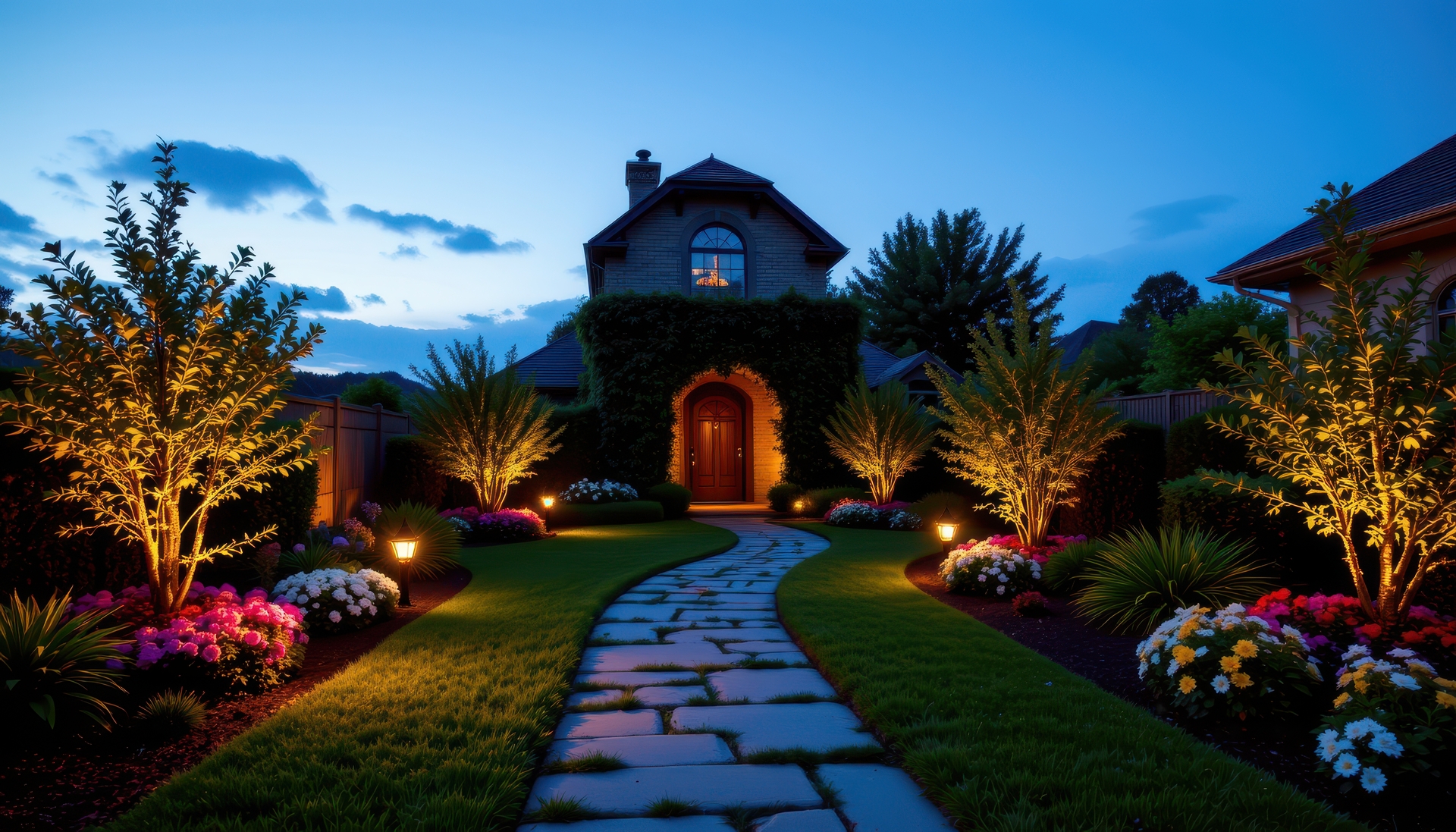Outdoor lighting has entered a new era—one where illumination is no longer passive but perceptive. Artificial intelligence is revolutionizing how light interacts with the environment, transforming outdoor spaces into intelligent ecosystems that respond to motion, weather, and human behavior. From private residences to public infrastructure, AI-powered lighting is redefining safety, efficiency, and aesthetics. The future belongs to systems that don’t just shine—they think.
The Rise of Intelligent Illumination
The foundation of AI-powered outdoor lighting lies in its ability to process data and make autonomous decisions. Traditional lighting relied on timers and sensors that operated on fixed patterns. AI, however, brings adaptive intelligence—learning from usage patterns, environmental changes, and even social behaviors to provide optimal lighting exactly when and where it’s needed.
This evolution marks a shift from static control to dynamic optimization. Smart lighting can detect foot traffic, adjust brightness based on time or season, and even communicate with other connected devices. The result is a living network of illumination—responsive, energy-efficient, and always aware of its surroundings.
How AI Enhances Energy Efficiency
Efficiency has always been at the heart of modern lighting, but AI takes it to new heights. By analyzing data from sensors and weather systems, AI algorithms can determine the precise lighting levels required in each moment. Lights dim automatically during low-activity hours and intensify only when movement or vehicles are detected.
This intelligent management significantly reduces energy waste. For homeowners, it means lower electricity bills. For cities and businesses, it means reduced carbon footprints and long-term cost savings. AI transforms energy efficiency from a manual adjustment to a fully automated process, balancing illumination needs with environmental responsibility.
Learning from Movement and Behavior
Unlike simple motion sensors that react instantly to presence, smart, AI-driven lighting systems can learn from behavior patterns over time. It can differentiate between a passing car, a pedestrian, or an animal, ensuring that light activation is precise rather than constant. In neighborhoods, this minimizes light pollution while maintaining safety and visibility.
Over time, systems can adapt to predictable patterns—brightening pathways before people arrive or dimming areas after inactivity. For public parks, pathways, and campuses, this predictive approach enhances comfort and safety while maintaining serenity. AI makes lighting not just reactive but anticipatory.
Integration with Smart Ecosystems
AI-powered lighting doesn’t operate in isolation—it thrives as part of a connected ecosystem. Through integration with smart home or city networks, it communicates with security cameras, alarms, and weather monitoring systems. When motion is detected, lights can trigger surveillance recording or notify homeowners. In urban areas, lighting can sync with traffic data to illuminate crossings or dim during low congestion periods.

This interconnectedness extends control and coordination far beyond individual fixtures. Municipalities benefit from centralized dashboards that oversee entire lighting grids, optimizing brightness, scheduling maintenance, and monitoring energy consumption in real time. Outdoor lighting has evolved into a system of intelligence that supports community-wide efficiency.
Predictive Maintenance and System Longevity
AI also introduces predictive maintenance, an innovation that saves time and reduces downtime. Smart lighting systems continuously monitor their own performance—detecting voltage irregularities, component degradation, or connectivity issues. Instead of waiting for failures, the system alerts technicians before a malfunction occurs.
For large-scale commercial or municipal setups, this predictive capability ensures consistent operation and extends equipment lifespan. Maintenance becomes data-driven rather than reactive. The result is improved reliability, reduced operational costs, and longer-lasting infrastructure.
Adapting to Environmental Conditions
Outdoor lighting is deeply affected by environmental variables like temperature, humidity, and natural light. AI integrates data from weather sensors to adjust output accordingly. During foggy nights, lights may increase intensity for better visibility; during full moons, they may dim automatically.
In coastal or high-altitude regions where conditions fluctuate rapidly, AI ensures stability and precision. It reduces strain on components by avoiding unnecessary output, preserving energy and extending fixture life. This environmental adaptability makes lighting systems not only intelligent but also sustainable under any condition.
Security and Safety Reinvented
AI-driven lighting brings a new dimension to security. By combining sensors with pattern recognition, lights can distinguish normal activity from suspicious behavior. For example, unusual movement patterns or lingering activity around restricted areas can trigger alerts or intensify illumination.
For residential properties, this adds an invisible layer of protection. Lights don’t just react—they analyze and respond with purpose. In public spaces, smart lighting improves pedestrian safety while deterring unwanted activity. It’s an evolution where illumination itself becomes part of the security system, actively contributing to peace of mind.
Aesthetic Precision and Design Intelligence
AI is also enhancing the artistic and emotional side of lighting. Through machine learning, systems can adjust hue, warmth, and brightness to match architectural design or seasonal themes. Homeowners can program dynamic scenes—soft amber tones for relaxation, cooler whites for focus, or colorful effects for gatherings—all automatically adjusted based on time and context.

Commercial properties and urban planners use AI to design adaptive lighting that complements building facades or public art installations. As AI learns from user preferences and environmental data, lighting becomes not only functional but expressive, shaping how spaces are perceived and experienced after dark.
Sustainability Through Smart Energy Management
Beyond convenience and aesthetics, AI is reshaping outdoor lighting’s role in environmental stewardship. Solar-powered systems integrated with AI can analyze battery levels, sunlight availability, and usage trends to manage energy intelligently. Lights prioritize high-traffic zones and dim non-essential areas to preserve stored power.
This smart allocation ensures reliable illumination even in low-sunlight conditions. It also reduces dependency on electrical grids, promoting renewable energy adoption. As sustainability becomes a global priority, AI-driven lighting offers a clear path toward greener, self-sufficient environments.
Data, Privacy, and Ethical Considerations
The intelligence that makes these systems powerful also raises important ethical questions. With sensors and data collection built into lighting infrastructure, privacy becomes a legitimate concern. Responsible design means limiting data storage, anonymizing information, and ensuring transparency in how collected data is used.
Balancing innovation with ethical responsibility will define the long-term success of AI in outdoor lighting. Systems must remain focused on efficiency, safety, and comfort—not surveillance. Clear communication and privacy safeguards will ensure public trust as these technologies continue to evolve.
The Role of AI in Smart Cities
Smart cities rely on connected technologies to improve urban life, and lighting is one of their most visible elements. AI-powered streetlights are being deployed worldwide, equipped with sensors that measure air quality, noise, and pedestrian flow. These insights inform city planning, safety policies, and energy management.
Through adaptive lighting schedules and coordinated responses to emergencies, smart streetlights reduce costs while improving livability. They form the backbone of urban intelligence—illuminating not just roads but the future of infrastructure design. The more connected a city becomes, the more integral its lighting network will be to communication and sustainability.
The Future of Adaptive Lighting Technology
As AI continues to advance, outdoor lighting will evolve beyond illumination into environmental intelligence. Future systems may integrate with drones, autonomous vehicles, or weather satellites to provide citywide optimization. Lights could dynamically guide evacuation routes during disasters or adjust color temperature to influence public mood and well-being.
With quantum computing and 6G connectivity on the horizon, the responsiveness of AI-powered lighting will reach unprecedented levels. Tomorrow’s systems will anticipate needs before they arise, blending digital precision with human comfort. The night will no longer just be lit—it will be orchestrated.
Conclusion: The Light That Thinks
AI-powered outdoor lighting is more than a technological upgrade—it’s a redefinition of how we interact with the environment after dark. Intelligent systems analyze, adapt, and optimize, ensuring that every lumen serves a purpose. From energy conservation and safety to beauty and personalization, the impact reaches every corner of modern life.
As cities, businesses, and homeowners adopt these innovations, the boundary between light and intelligence continues to fade. The nights ahead will not only be brighter—they’ll be smarter, guided by systems that think, respond, and evolve alongside us.

Leave a Reply